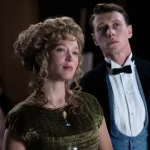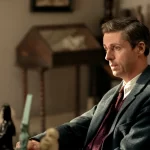LA Film Fest part one, by David Bax
Winter in the Blood
Back in 2002, Alex and Andrew Smith made a film called The Slaughter Rule. That movie – about an angry teenager processing the death of his father while balancing the struggles of his replacement paternal figure, his football coach, and the peculiarities of becoming a man himself – made a deep impression on me. I consider it to be the among the best and most frustratingly underseen films of its decade. So it was with great eagerness that I jumped at the chance, eleven years later, to see the Smiths’ follow-up, Winter in the Blood.
Based on a novel by James Welch, Winter in the Blood is about a man whose father’s death is not so recent as in The Slaughter Rule but which hangs similarly in the atmosphere. Virgil, a Native American man living in Montana, spends the film thinking about his father and older brother, both dead, while drinking, stumbling, fighting, flirting and finding odd jobs while attempting to get back the rifle his wife took when she left. He’s so drunk for most of the movie, it’s unclear both to him and to us which things we see actually happened and which are dreams or hallucinations.
Virgil, a lazy and unreliable alcoholic, begins the film rather difficult to like. As we see more of the flashbacks to his childhood that are peppered throughout, we come to understand sympathize with him, though the Smiths and screenwriter Ken White continue to challenge that sympathy. The film does not let Virgil off the hook for being the way he is. It’s up to him to do that.
As in The Slaughter Rule, the Smiths employ a meandering style that is impressionistic without ever being showy. Voiceovers and images fade in and out. Time seems to expand and contract. And the guitars on the soundtrack (lent by the Heartless Bastards) trip dreamily along, not directionless but not exactly sure where they’re going either.
The winter of the title is not onscreen; with the exception of a few flashbacks, the film takes place in the heat of summer. But, as the name suggests, winter represents something just under the surface. There’s something in the blood, in the animals, in the dirt, in the town and in the liquor. Maybe it’s the heavy darkness of reality and maybe it’s in all of us. Virgil’s pain is caused either by his embracing it too much or not at all. His struggle to do so is beautifully realized.
The Act of Killing
It’s probably best to go into The Act of Killing knowing as little as possible. That’s not because it has lots of twist and reveals, though there are things you could not have predicted within. No, there are two reasons one would do best to avoid reading too much about this film. First off, knowing how horrifyingly disturbing the film becomes might scare you off, which would be a shame. And secondly, a facile look at the premise makes it sound cynical and amorally glib.
Since you’ve decided to read about it anyway, I’ll lay out the plot. After a failed coup in 1965, the government of Indonesia enlisted gangsters to form death squads that helped to kill as many as 1,000,000 communists, Chinese and other perceived domestic threats. These men are now folk heroes of a sort, smiled upon by the leadership that spurred these atrocities and is still in power today. Director Joshua Oppenheimer asked these men, now senior citizens, to recreate scenes from their memories of slaughter in the styles of their favorite movies. The killers cast themselves as gangster or cowboy antiheroes, strutting and playing dress-up as they reenact the ways they garroted, burned and raped thousands of their fellow countrymen.
Though it is often sickly funny, the film does not preoccupy itself with ridiculing the aged criminals. In many ways, they do this to themselves. When the lower-ranking men posture buffoonishly like they’re Edward G. Robinson, they’re easy to mock. Until you are reminded that they did (and do) in real life what Robinson pretended to do on screen. Theft, extortion and, of course, murder are simple facts of life. And these men are held in high esteem by many members of the government. So, at one point, when one of them is lounging about in a free t-shirt from a “Pioneer Days” festival from some small American town (who knows where he got that), the laughs come easy. The pioneers sought freedom, right?
Then, later, we are in a car with another member of this crew, a smarter one who seems to truly understand the depths of inhumanity to which he sank and the extent of his cruelty. But he is also the most chilling because, despite being honest with himself, he feels no sorrow. At least the others have the excuse of their ignorance. But this man, when asked by the filmmakers about the idea of war crimes or crimes against humanity – none of which have ever officially been leveled at the perpetrators – he scoffs. Did anyone in America ever get prosecuted for the genocide of the American Indians? 50 years have passed since the mass killings in Indonesia. Far more than that has passed since the days of smallpox blankets and trails of tears. The number of people in both cases who have paid for these sins is the same. If we had killed the Native Americas at a time when cinema existed, it’s easy to believe we would have viewed our memories of the acts through the scope of popular movies. What makes The Act of Killing so nightmarish is that it not only brings us face to face with monsters but that it also allows us to recognize their humanity.
Amarcord
Shown as part of the festival’s “Retro” showcase, 1973’s Amarcord is a late-period Fellini film that I had never seen. If you are, perhaps, a Fellini detractor, it would be possible for you to locate everything about the director you find objectionable in this one film. It is shrill, uneven and vulgar. Personally, I loved it.
The things depicted in this portrait of a small, Italian town during the days of Mussolini require a deft hand, which Fellini deceivingly possessed under all his layers of bombast and volume. All the wanton, sophomoric humor, the ignorance, the cruelty and misogyny; these things would be unbearable were Fellini not such a humanist. We see the yearning behind the schoolboy shenanigans. We see the wonder behind the provinciality. We even see the pain suffering behind the eyes of the town slattern.
By the film’s end, we’ve spent a year in the town. We’ve decided whom we like and whom we don’t. But we recognize all of them, living in a world as ugly and as beautiful as our own.
My Stolen Revolution
The 1979 Iranian revolution is sometimes known as the Islamic Revolution. It definitely put the Islamists in power but that name is a misnomer nonetheless. The lead-up to the overthrow of the Shah relied on plenty of secular participation as well. Tragically, those secular revolutionaries, many of them communists, immediately became the enemies of the new rulers they’d helped to put in power.
My Stolen Revolution is a documentary that consists of one such communist who escaped the country, director Nahid Persson, and her conversations with five other women who didn’t and all went to prison. What happened to the regime’s new political prisoners, especially when they were women?
The resulting film contains stories of such emotional impact that they overpower the more amateurish aspects of the production (ham-fisted narration, obviously staged shots). When these women are able to tell stories of being made to stand facing a wall for hours on end, wearing a chador and repeatedly being slammed into the bricks; when they talk of spending almost all of every day for six months crouched in a box with no light; when they tell the story of the day they were raped; and, after all this, when they are able to be happy and smart and determined women, it’s an uplift that is more than earned.
My Sister’s Quinceanera
It would not be a lie to say My Sister’s Quinceanera, a film by Aaron Douglas Johnston, is a portrait of a Latino family living in a smallish Iowa town. But to describe it as such would be irresponsible, making the film sound like a dry, sociopolitical exercise. It’s much more than that, if it is even that at all.
Silas is the eldest child in his family. His mother is the matriarch and her husband is absent. It is implied he’s on the other side of the border, perhaps sending money home. In any case, Silas is the man of the house. He’s also of college age and of college ambition, though his soft, quiet demeanor and commitment to his family and the role he’s inherited make that difficult to see.
Johnston uses low-key naturalism not just as an aesthetic choice as an end to itself, but to make minor moments as major to us as they are to Silas. We don’t need a musical sting when his friends reminds him how long he has to register for classes. And a silent moment of frustration wherein Silas proves to himself and to us how ready he is for higher education passes unremarked upon, over as quickly as it’s begun. And yet the whole film has changed.
My Sister’s Quinceanera is not just a story about the banal, dull grind of the American dream, where progress comes not in huge revelations but in a multitude of tiny decisions. It’s also a warm, funny, deftly observed slice of life.
Ain’t Them Bodies Saints
Ain’t Them Bodies Saints starts off with a deficit because it’s called Ain’t Them Bodies Saints. I mean, how is that going to affect word of mouth? Are you really going to recommend your friends go see a movie called Ain’t Them Bodies Saints? In order to get away with a name like that, it would have to be exceptional. David Lowery’s film is in many ways decent, competent, occasionally even above average. But it’s not quite that good.
Ruth Guthrie (Rooney Mara) and Bob Muldoon (Casey Affleck) are a couple. They are criminals of an unspecified sort and, as the film opens, we find out that they are going to be parents. Two scenes later, though, a particular crime (again unspecified) has gone wrong and they are involved in a shoot-out with the police. Their cohort, Freddy (Kentucker Audley) is killed and Ruth shoots and wounds a police officer. Before being caught, Bob decided to take the fall for everything and do the time while Ruth raises their child. Four years later, Ruth and daughter Sylvie are living in a house owned by Freddy’s father, Skerritt (Keith Carradine) and Ruth has befriended the wounded officer, Patrick (Ben Foster), when the news breaks that Bob has escaped from prison and he is coming back for them.
Frankly, it’s a pretty fantastic set-up for a movie. It has all the “kiss kiss, bang bang” promise a movie needs, as well as a heavy dollop of tough and sweaty Texas atmosphere. Furthermore, all of those requirements are duly fulfilled by Lowery (who, I’m mostly certain, is not the guy from mid-90s alt-rock outfit Cracker). It’s just that he does nothing above coloring inside the lines. There’s little sense of personality or vision and even less of joy.
Lowery’s cast does their best to help him out, particularly Carradine, who is incapable of being bad in anything, and Foster, who has been one of America’s most consistently underrated character actors for more than a decade now.
Still, it’s hard to get past the feeling that no one on either side of the camera, in character or out, is enjoying her- or himself. Everything is relentlessly grim and dour without earning the weight to make that mean something. It’s not until a flashback near the very end of the film that we get a look at Ruth and Bob enjoying each other’s company. It’s sweet and touching and it made me think, “I’d watch a movie about those two people.”
The Expedition to the End of the World
Due to the warming of the planet, there are fjords in the northern edges of the world that are now reachable for three weeks annually that were previously inaccessible for thousands of years. Daniel Dencik’s The Expedition to the End of the World follows a group of scientists and artists as they become the first humans since perhaps the Stone Age to set foot on these shores. Expectedly, it is beautiful to behold. Unexpectedly, it is one of the most entertaining, sharp-edged and funny documentaries in years.
The camaraderie among the crew is immediately evident, as is the sense of healthy antagonism between the artists and scientists that comes with it. There’s an overriding impression that, yes, these men and women are here to document and learn but they also find this all very exciting and fun.
Amongst all the good-natured and highly intelligent insults, the encounters with polar bears and the thrash metal, a theme begins to emerge. The world is changing and we are changing it. But it’s not the planet that is in danger. It is we. We may or may not be the cause of our own extinction but the world will continue long after just as it did long before. And all of this is relayed with little more than curiosity and a dry sense of humor.
Forty Years from Yesterday
The less said about Robert Machoian and Rodrigo Ojeda-Beck’s Forty Years from Yesterday, the better. For an interminable 76 minutes, it trains an unblinking and uninterested camera on the aftermath of a woman’s death in her sleep. Though it occasionally becomes interesting when we see the backroom details of how a body is prepared for a funeral, it fails to reflect that sense of process into the other side of the film, where the woman’s husband and three grown daughters grieve, mostly silently. I became so disinterested in their mourning, I began to look for signs of life in the actress playing the dead body. There were more of them there than in the rest of the film.
You’re Next
When direct Adam Wingard and screenwriter Simon Barrett introduced You’re Next, they stated that they wanted to claim horror films back from the bleak and depressing and make something that the audience could really enjoy. During the first act or so, I wasn’t sure they’d succeeded. Certainly, the film I was watching was very well-made but the brutality I was witnessing on screen wasn’t what I would call fun. Then I realized that Wingard and Barrett had just been setting the table, getting me into a mental space where I could feel the full impact when the protagonist – and, therefore, the film – started to really kick ass.
A wealthy couple has invited their four grown children and each of their significant others (that’s ten potential victims, if you’re counting) to their expansive, secluded mountain vacation home to celebrate their 35th anniversary. Then, in the middle of a nice dinner, dudes in creepy masks show up and start firing freaking crossbows at them through the window. And it goes on from there.
One thing about You’re Next that immediately stands out is its sense of humor. The jokes in horror movies, when they even exist, tend to either be cheesy (Chucky’s one-liners) or overpower the scares (arguably, Scream). But Wingard belongs to a new crop of witty filmmakers who are also interested in delivering old-school scares and shocks. Ti West, who appears in the cast of this film, can also be counted among these ranks. His The Innkeepers is one of the scariest films of the decade so far and also possesses the hilarious, laid-back banter of a sly and subtle workplace comedy. Most of the humor here comes from a few key actors. Barbara Crampton is the high-strung mother who just wants everyone to have a good time. AJ Bowen is the college professor son whose bearded gentleness and soft plaid barely mask an ineffectual rage. And Wendy Glenn is the self-consciously “alterna” girlfriend of the clan’s youngest son, smoking her cigarette and rolling her eyes with a hilariously practiced disaffectedness. But it’s filmmaker Joe Swanberg as the smarmy son who isn’t happy unless his siblings are miserable who steals the show. Even with an arrow protruding from his shoulder and large amounts of blood pooling around him, he finds the vitriol to continue hilariously insulting his kin.
Laughs are only a fraction of the responses you’ll hear if you see this with an audience, which I suggest you do. Applause, gasps, cheers, whatever sound people make when they are grossed out; not a scene goes by without a hearty reaction from the crowd.
That goes back to what Wingard and Barrett said before the screening. By creating a horror film that not only gives the viewer a multitude of thrills but that also refrains from ever insulting the viewer’s intelligence (you won’t once find yourself thinking, “Don’t go in there!”), they truly did keep the audience in mind. Go see You’re Next and take all of your friends. These guys deserve it.



































